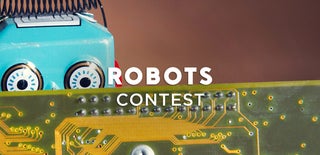Introduction: Pandemi: the Low-Cost Robotic Disinfection System
This is a cheap, easy to make robot.
It can sterilize your room with UV-C light, it is light and agile, it can go on any terrain, and it can fit in any doorway. It is also human-safe, and fully autonomous.
Supplies
- PIR Motion Sensor - here
- HC-SR04 Ultrasonic Sensor - here
- Male-Male Jumper Wires - here
- Male-Female Jumper Wires - here
- Black Gladiator Robot Chassis - here
- Arduino Nano R3 - here
- Breadboard - here
- UV-C Lamp - get it here
- B22 to E27 Lamp Converter - get it here
- Power Inverter - DC 12 Volts to AC - 150 watts - here
- Relay Module - here
- 3 SMD RGB LED Breakout Boards - here
- Cardboard Box
- Adafruit DRV8833 Motor Driver - here
- 2 9V Batteries - here
- 1 9V to Barrel Jack Connector - here
- 9 Standoffs - here
- Small cardboard box
Tools:
Step 1: Chassis
To start off, I am on a really low budget, so I couldn't get a UV light :(
Second, my camera has a lens problem, so I apologize.
Let's get started!
Build your Black Gladiator Chassis and fit the tracks to it.
Step 2: Wiring
This is the hardest part.
Because there are so many wires, I didn't make a circuit diagram, but the list below shows the pin numbers.
Pin Numbers:
- "R" pin of your SMD RGB LED to pin 2 *
- "B" pin of your SMD RGB LED to pin 3 *
- Output of your PIR to pin 8
- Trig of your HC-SR04 to pin 9
- Echo of your HC-SR04 to pin 10
- Switch of your relay to pin 11
DRV8833 Pins:
- AIN1 to pin 4
- AIN2 to pin 5
- SLP to 3.3 V
- BIN2 to pin 6
- BIN1 to pin 7
- AOUT 1 to Left Motor, Labeled Side
- AOUT 2 to Left Motor, Unlabeled Side
- BOUT 2 to Right Motor, Unlabeled Side
- BOUT 1 to Right Motor, Labeled Side
- Another thing about the motor wires - make up some alligator clip jumpers like I did here, put a breadboard jumper cable in one clip, and attach the other clip to the motor terminal. Do this for all four wires.
UV-C Light Wiring:
- Connect it to the relay like this(just don't do the ESP or circuit board).
* Connect all three wires to one breadboard bus and link one other wire back to the respective Arduino pin.
Step 3: Assembly
Follow the pictures of what it should look like.
Put standoffs in 4 holes on the chassis. Screw the nuts on the bottoms. Then make holes that align with the standoffs on a flat piece of cardboard that should be a little bigger than the chassis itself.
Screw the screws in the top of the cardboard holes and standoffs. There should be an aluminum foil baffle on the light's top.
Look at the pictures to see what I mean. A picture is worth a thousand words, right? :)
Step 4: Chassis Cover
Cover the cardboard box with black construction paper, like in the picture. Put the small cardboard box on the front of the top and glue it in.
Drill a hole in the bottom and top of the small cardboard box. Then drill a hole in the top of your large cardboard box that is in exactly the same spot as the hole in the bottom of the small cardboard box. This hole is for the wires of the PIR sensor and SMD RGB LEDs.
Refer to the pix for more.
Cut a rectangle in the front of the large box for the ultrasonic sensor.
Cut a hole in the front of the small box for the PIR.
Step 5: Coding
Disable the SLP pin, so your robot doesn't run away while uploading. Upload the code to the Arduino Nano.
Enable the SLP pin, place your powered-down robot on a cleared floor surface, and turn it on. There will be a 30 second delay before it starts, so the PIR can calibrate. After 30 seconds, the robot will start.
Step 6: Usage
Turn it on and exit the room. If all goes well, the robot should wait until you exit the room, calibrate it's PIR sensor, and start disinfecting. If a human enters the room, it will shut down immediately.
The specs are in the linked GitHub repository.
Step 7: Disclaimer and End
Disclaimer:
If anyone is blinded, burned, or injured in any way, or if damage is caused to pets, property, or any other thing, I am not responsible,liable, or required to make any reparations for the damage.
If your Robotic Disinfection System works, congratulations!
If it doesn't, reread the wiring step.
Thanks for reading! Please consider voting for me in the Robots Contest!
Merry Making,
g3holliday

Participated in the
Robots Contest











